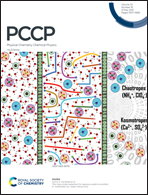Formic acid dehydrogenation over PdNi alloys supported on N-doped carbon: synergistic effect of Pd–Ni alloying on hydrogen release†
Abstract
Bimetallic Pd1Nix alloys supported on nitrogen-doped carbon (Pd1Nix/N–C, x = 0.37, 1.3 and 3.6) exhibit higher activities than Pd/N–C towards dehydrogenation of formic acid (HCO2H, FA). Density functional theory (DFT) calculations provided electronic and atomic structures, energetics and reaction pathways on Pd(111) and Pd1Nix(111) surfaces of different Pd/Ni compositions. A density of states (DOS) analysis disclosed the electronic interactions between Pd and Ni revealing novel active sites for FA dehydrogenation. Theoretical analysis of FA dehydrogenation on Pd1Nix(111) (x = 0.33, 1 and 3) shows that the Pd1Ni1(111) surface provides optimum H2-release efficiency via a favorable ‘HCOO pathway’, in which a hydrogen atom and one of the two oxygen atoms of FA interact directly with surface Ni atoms producing adsorbed CO2 and H2. The enhanced efficiency is also attributed to the blocking of an unfavorable ‘COOH pathway’ through which a C–O bond is broken and side products of CO and H2O are generated.



 Please wait while we load your content...
Please wait while we load your content...